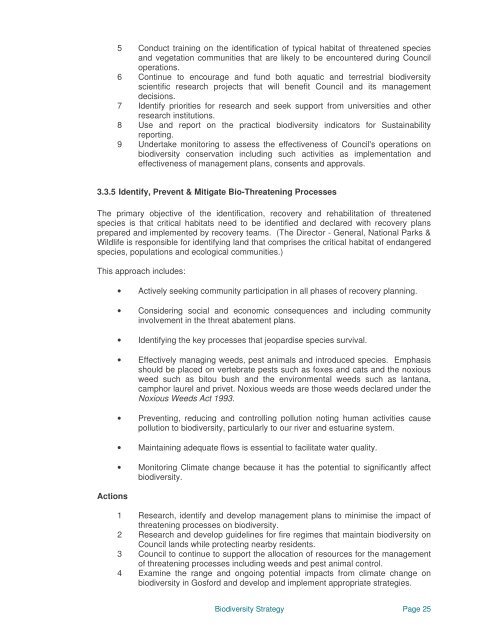Biodiversity Strategy - Gosford City Council - NSW Government
Biodiversity Strategy - Gosford City Council - NSW Government
Biodiversity Strategy - Gosford City Council - NSW Government
Create successful ePaper yourself
Turn your PDF publications into a flip-book with our unique Google optimized e-Paper software.
5 Conduct training on the identification of typical habitat of threatened species<br />
and vegetation communities that are likely to be encountered during <strong>Council</strong><br />
operations.<br />
6 Continue to encourage and fund both aquatic and terrestrial biodiversity<br />
scientific research projects that will benefit <strong>Council</strong> and its management<br />
decisions.<br />
7 Identify priorities for research and seek support from universities and other<br />
research institutions.<br />
8 Use and report on the practical biodiversity indicators for Sustainability<br />
reporting.<br />
9 Undertake monitoring to assess the effectiveness of <strong>Council</strong>'s operations on<br />
biodiversity conservation including such activities as implementation and<br />
effectiveness of management plans, consents and approvals.<br />
3.3.5 Identify, Prevent & Mitigate Bio-Threatening Processes<br />
The primary objective of the identification, recovery and rehabilitation of threatened<br />
species is that critical habitats need to be identified and declared with recovery plans<br />
prepared and implemented by recovery teams. (The Director - General, National Parks &<br />
Wildlife is responsible for identifying land that comprises the critical habitat of endangered<br />
species, populations and ecological communities.)<br />
This approach includes:<br />
Actions<br />
• Actively seeking community participation in all phases of recovery planning.<br />
• Considering social and economic consequences and including community<br />
involvement in the threat abatement plans.<br />
• Identifying the key processes that jeopardise species survival.<br />
• Effectively managing weeds, pest animals and introduced species. Emphasis<br />
should be placed on vertebrate pests such as foxes and cats and the noxious<br />
weed such as bitou bush and the environmental weeds such as lantana,<br />
camphor laurel and privet. Noxious weeds are those weeds declared under the<br />
Noxious Weeds Act 1993.<br />
• Preventing, reducing and controlling pollution noting human activities cause<br />
pollution to biodiversity, particularly to our river and estuarine system.<br />
• Maintaining adequate flows is essential to facilitate water quality.<br />
• Monitoring Climate change because it has the potential to significantly affect<br />
biodiversity.<br />
1 Research, identify and develop management plans to minimise the impact of<br />
threatening processes on biodiversity.<br />
2 Research and develop guidelines for fire regimes that maintain biodiversity on<br />
<strong>Council</strong> lands while protecting nearby residents.<br />
3 <strong>Council</strong> to continue to support the allocation of resources for the management<br />
of threatening processes including weeds and pest animal control.<br />
4 Examine the range and ongoing potential impacts from climate change on<br />
biodiversity in <strong>Gosford</strong> and develop and implement appropriate strategies.<br />
<strong>Biodiversity</strong> <strong>Strategy</strong> Page 25
















